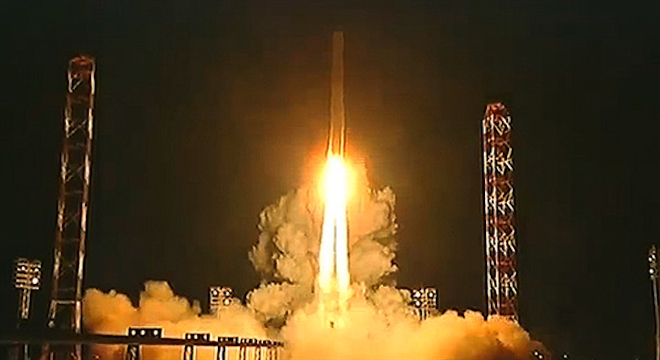Scientists have given up on any hope of regaining even minimal control over Russia’s wayward spacecraft Phobos-Grunt, which successfully launched for Martian moon Phobos on November 8, only to lose contact with engineers shortly thereafter and fail to boost out of Earth’s orbit, where it currently remains trapped.
The craft may now be breaking apart. At least two pieces of debris believed to have separated from the Phobos Grunt were reportedly detected by the U.S. Army’s Strategic Command, according to the Moscow Times on Tuesday, citing a report from news and intelligence outlet Interfax.
We’ve reached out to the U.S. Strategic Command for more information and will update when we receive a response.
Meanwhile, Canadian amateur satellite watcher Ted Molczan also said that two objects had broken free of Phobos-Grunt and disintegrated, RT reported (using an alternate spelling of Molczan’s last name).
On Friday, the European Space Agency, which had briefly made contact with the wayward spacecraft in late November, announced it was ceasing its attempts to re-establish a connection with the Phobos Grunt and issue commands to push it safely into higher orbit.
“In consultation and agreement with Phobos-Grunt mission managers, ESA engineers will end tracking support today,” the European Space Agency said in a release Friday. “Efforts in the past week to send commands to and receive data from the Russian Mars mission via ESA ground stations have not succeeded; no response has been seen from the satellite. ESA teams remain available to assist the Phobos-Grunt mission if indicated by any change in the situation.
“We will stay available for our Russian colleagues in case there is any sign or glimpse of hope from their side,” said Dr Manfred Warhaut from ESA’s European Space Operations Centre (Esoc) in Darmstadt, Germany, the BBC reported.
Now, the focus of both the Russian Space Agency (Roscosmos) and the European Space Agency has shifted to when and where exactly the Phobos-Grunt spacecraft will re-enter Earth’s atmosphere in an uncontrolled free fall.
The spacecraft is locked in a decaying orbit around Earth, but enough will soon accumulate enough drag to send it spiraling back toward’s the surface, likely sometime between late December and early February, according to Russian news outlet Itar-Tass.
However, another report from the news outlet quoting Roscosmos deputy chief Vitaly Davydov notes that no accurate prediction will be available until 12 hours before re-entry.
“It is senseless to say where it will fall before this,” Davydov said, Itar-Tass reported.
While uncontrolled re-entries occur with astoundingly relative frequency (around one small object a day, NASA said earlier this year), the descent of the Phobos-Grunt is worrisome because the spacecraft still contains about 8 tons of toxic hydrazine fuel.
Russian officials say that it will burn up during re-entry and poses no threat to the ground, SPACE.com reported.
Still, that’s done little to quell the spread of conspiracy theories about the spacecraft’s failure across the Web. Among these is one proposed by YouTube’s “UndercoverAlien” that explains Phobos Grunt was actually designed to fail and crash to earth as a kind of elaborate biological weapon.
Conspiracy theorists have latched on the fact the spacecraft was also carrying several samples of bacteria as part of its Living Interplanetary Flight Experiment, a collaboration between Roscosmos, the German Aerospace Agency and international non-government agency the Planetary Society to test the hypothesis of transpermia, that microorganisms could survive space-travel if carried aboard rocks. The Planetary Society notes “None of the microbes will be dangerous to humans.”
But back here on Earth, the $163 million spacecraft’s spectacular failure is already being felt, at least in Russia. Russian President Dimitri Medvedev recently proposed implementing harsher, even criminal penalties for those responsible for the country’s space mishaps.
“I am not suggesting putting them up against the wall like under Josef Vissarionovich (Stalin), but seriously punish either financially or, if the fault is obvious, it could be a disciplinary or even criminal punishment,” Medvedev said, The Flame Trench reported.
The failure of the Phobos-Grunt marks Russia’s 18th consecutive failure over the past 50 years to send and operate a spacecraft on or near Mars. Meanwhile, the United States recently successfully launched its nuclear-powered Mars rover, Curiosity, which is expected to reach the Red Planet by August 2012.









